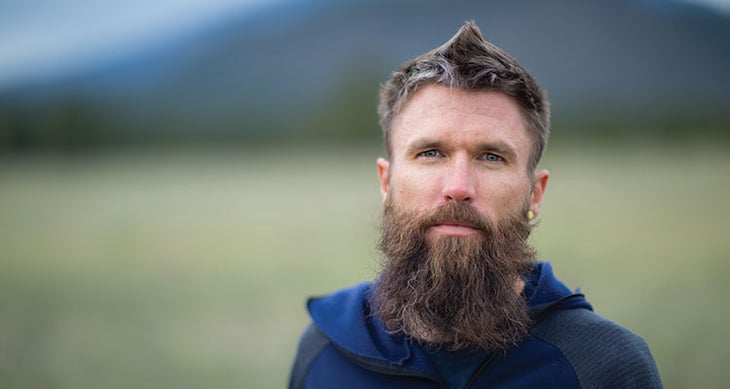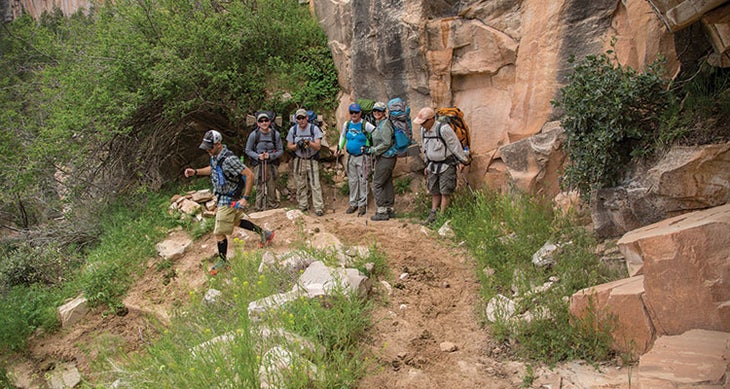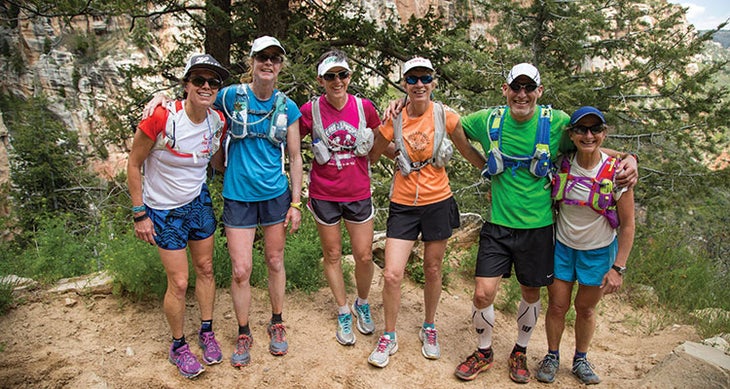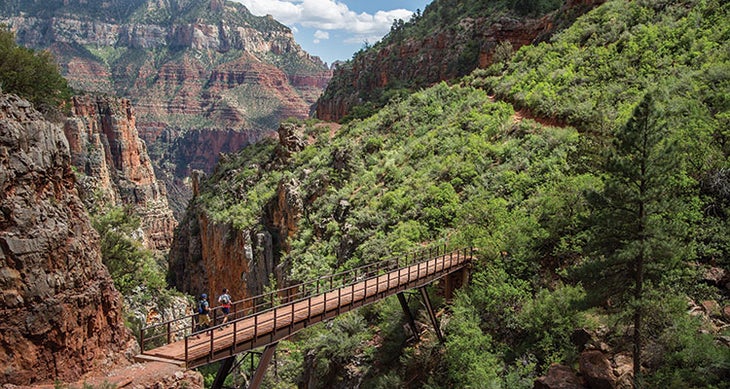Heading out the door? Read this article on the new Outside+ app available now on iOS devices for members! Download the app.
Phantom Ranch, at the bottom of Grand Canyon, is typically a sleepy backcountry haven. Tucked beside a cottonwood-shaded creek, the historic cabins and cantina perfectly match the timeless geology. It’s not the kind of place you expect to see a 10K. But that’s exactly what it looked like in May 2015. It was opening weekend of the North Rim, ushering in a new season of rim-to-rim travel. The weekend is one of the busiest times of year for rim-to-rim speed hikers and runners, who have been waiting all winter. They passed through by the hundreds.
Men and women wearing fat Hoka running shoes and knee-high compression socks anxiously milled around, looking at their watches while they waited for the bathroom or for their slower running partners. Others were just running through, taking the path, any path, of least resistance. Every so often a runner with a sprained ankle or swollen knee would limp into the cantina looking for ice. A couple who had just gotten married and were running rim-to-rim for their honeymoon stopped to look for the best man, who had come along.

Just over a century ago, President Theodore Roosevelt established federal protection for the Grand Canyon and said, “Let this great wonder of nature remain as it now is. Do nothing to mar its grandeur, sublimity, and loveliness. You cannot improve on it. But what you can do is to keep it for your children, your children’s children, and all who come after you, as the one great sight which every American should see.”
What he didn’t say was how it should be seen.
Recreation tastes change. When Roosevelt was here, riding a mule on a leisurely trip to the river was the trendy way to travel. Mules still make the journey, but hikers and backpackers have long since outnumbered them.
Today, a new trend is ushering in a trail revolution of its own. Since 2013, when Grand Canyon first started tracking corridor trail traffic, rim-to-rim day trips have increased by 25 percent each year. (Connecting the North and South Rims via the South Kaibab and North Kaibab Trails entails 22 miles and more than 10,000 feet of elevation change.) On one day in 2014, 300 people started a rim-to-rim hike or run on the North Kaibab Trail in a single three-and-a-half-hour period. Runners are literally colliding with backpackers and mule riders during busy spring and fall weekends.
“Running in the park is not a bad thing, but the rim-to-rim runner has a different goal than the casual dayhiker or backpacker,” notes Grand Canyon Wilderness Coordinator Linda Jalbert. “They are very concerned about how fast they’re going—their trip is a timed event—and this can lead to disregard for other visitors. In a lot of ways it is an etiquette problem.” Jalbert and other park managers are grappling with how to maintain peace among divergent trail users while somehow preserving the majestic Grand Canyon experience that Roosevelt championed.
It’s a challenge rattling the entire park system. People are now seeking to experience the parks in ways officials never anticipated—and which decades-old management plans don’t accommodate. For pursuits like BASE jumping in Yosemite and geocaching in any national park, management plans implemented before these activities even existed currently make them illegal. Other newly popular sports, such as standup paddleboarding, packrafting, and trail running, are generally allowed but are growing faster than the parks’ ability to manage them.

A study published by Grand Canyon officials in July 2015 found that about one third of visitors interviewed said “rude and inconsiderate” trail users were a problem. Even though half the trail users counted in the survey were hikers and only 9 percent were trail runners, one third of the complaints about rudeness had to do with the behavior of runners. (It’s possible that the survey was skewed toward the hiker perspective, as runners may not have wanted to stop to comment.)
A longtime Grand Canyon backpacking guide says she’s witnessed some of the problems firsthand. “I’ve often been awakened in the middle of the night at Cottonwood Campground (on the North Kaibab Trail) or Phantom when runners are coming through talking to their GoPros,” she says (she did not want to be named because of her role as an outfitter). “They’re banging on the bathroom door at Phantom Ranch and stepping on your heels on the trail.”
“It’s not the sport that’s the problem, it’s some of the people,” says Ian Torrence, one of Grand Canyon trail running’s chief advocates. The Flagstaff-based running coach has run rim-to-rim-to-rim, covering 44 miles and 21,000 feet of elevation gain and loss, 10 times. “I just prefer to run in the park rather than to hike or ride a mule,” he says. “I like the exhilaration of running and covering a lot of ground in a day.” But Torrence admits runners can get tunnel vision. “They have their endorphins going and are moving fast so they are not as aware of others on the trail as they should be.”

While some runners on the Fastest Known Time website lament not being able to break a rim-to-rim record because they were slowed on the trail by a mule train, Rob Krar, the record holder (2 hours, 51 minutes, 28 seconds), says safety needs to come before speed. “Running up on a hiking group and startling them can cause a serious accident,” he says. “Falling in Grand Canyon can be deadly.” Krar calls out to hikers well be before he meets up with them to give them time to decide what to do. “I don’t want to be that guy who people are complaining about,” he says.
Other Western national parks are also becoming popular proving grounds for runners. If there were a national park ultrarunning triple crown it would be Grand Canyon’s rim-to-rim-to-rim, Zion’s Trans-Zion route, and Mt. Rainier’s Wonderland Trail.
“Trans-Zion has really blown up in popularity over the last five to six years,” says Zion National Park’s Plateau District Ranger Andrew Fitzgerald. “I used to just encounter the occasional local runner, but now I see groups of runners every day.”
The 48-mile Trans-Zion route ranges in elevation from 4,000 to 7,500 feet, and backpackers typically do the route in four to five days. Runners? The Fastest Known Time, set in 2013, is 7 hours, 22 minutes, 8 seconds. Fitzgerald says there have been few conflicts between runners and backpackers, but he is worried about the violation of group-size rules in the park’s designated wilderness. While group size is easy to control with backpackers who must obtain campsite permits, it’s hard to monitor with organized runners who are moving fast and not spending the night.
Fitzgerald says the popularity of Trans-Zion among competitive runners has also lead to an increase in rescues. “They get caught by surprise when the weather changes. When they are above 7,000 feet it can start snowing all of a sudden and they are only wearing shorts and a T-shirt.”
However, in parks where weather surprises and backcountry users are few and far between, land managers welcome runners. “We have had zero issues with trail running,” says Joshua Tree National Park Superintendent David Smith, who is himself an ultrarunner. Joshua Tree is an increasingly popular running destination, especially for its 37-mile traverse (the record is 7 hours, 12 minutes, 50 seconds), but Smith says the use is still largely dispersed across the park’s 790,000 acres. “A trail runner in our backcountry is likely to encounter very few people,” he says.
As for Grand Canyon, a draft of the park’s revised backcountry management plan (last updated in 1988) released in November floats the idea of requiring a day-use permit for all hikers and runners who venture below the Tonto Plateau. Another possibility is to only allow organized running events during certain times of year or to have slow zones on certain sections of trail. As interim measures, managers have developed a Leave No Trace program aimed at educating runners on trail etiquette. The park also now requires a permit for organized rim-to-rim treks that limits group size to 30 people.

For Jalbert and other park managers who are hoping to have the new backcountry management plan in place by summer 2017, the challenge is balancing “emerging uses” with long-held ones that are still very important to park visitors. “Backpacking on the corridor trails is a great trip for first-time visitors to Grand Canyon,” explains Jalbert. “And many people try for years to obtain a permit to stay at Phantom Ranch. When they finally get there, they’re expecting a quiet and quaint setting. We want to preserve the opportunity for these kinds of experiences, too.”
But one thing will never change. Whether it takes four days or four hours to cross it, the Grand Canyon has a way of cutting you down to size. “The canyon has taught me humility,” says Krar, the rim-to-rim record holder. “There have been moments at the river when I thought I would never get back to the rim. You have to give the canyon respect. Everybody has a right to experience that. Sure, we have to find a balance, but everybody has a right to be in the canyon.”
Southwest Field Editor Annette McGivney has done more than 100 Grand Canyon hikes. Her “record” for the rim-to-rim is three days.